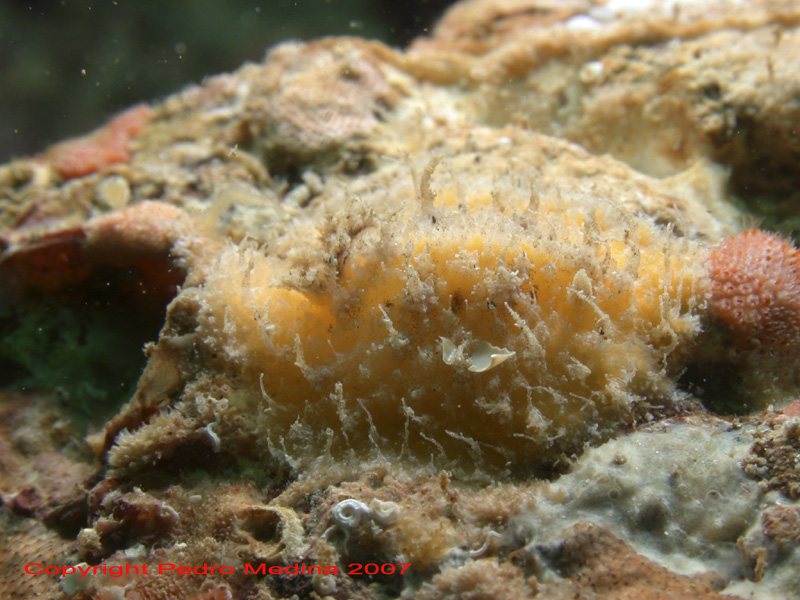 |
Banderas Bay, Puerto Vallarta, Mexico
Photo courtesy of Pedro Medina
Discodoris aliciae Dayrat, 2005
This seemingly epibiotic-encrusted dorid , is actually covered with complexly branching, long papillae on its dorsal surface. These papillate papillae often resemble a truly “bad hair day,” with long, thin, “unruly” projections. They have a “characteristic morphology. One main central papilla is flanked by secondary papillae around its base; those secondary papillae are tubercles with a distinct apical knob; the central papilla is elongated and conical...; the main papillae and the secondary papillae also bear spicules protruding from their base” (Dayrat, p. 222). The basic coloration of the body is dull orangish ; the rhinophores, gills and dorsal papillae are all darker than the ground color. The ventral foot surface is a surprising bright orange-yellow, with numerous brown spots on the underside of the notum. It has 6 tripinnate gills , and the rhinophores bear 18 lamellae.
Befitting its cryptic morphology and pattern, it has been seen in caves and underneath rocks. This 30-45 mm long species has been found at Bahía Banderas, Nayarit, and Manzanillo, Colima, México, and Islas Coiba and Canal de Afuera, Panamá.
Described radular formulae are 38 x 42.0.42 and 45 x 40.0.40. “All teeth are simply hamate, except for the outermost tooth, which is almost needle-like due to its reduced size. The teeth bear no denticles, nor are they grooved” (Dayrat, p. 222).
The reproductive system : “The ampulla is straight and makes no loop. It enters immediately into the female gland mass. The division between male and female ducts could not be seen by dissection....The prostate is divided into two parts, a proximal whitish part and a distal yellowish part....The deferent duct does not make distinct coils or loops. No distinct penial papilla was observed. The deferent duct, the vaginal duct and the female gland mass all join in a common atrium. No distal accessory gland was observed. Some differences were observed among individuals” (Dayrat, pp. 222-223).
Dayrat describes aspects of the general anatomy , including the digestive and reproductive systems.
(Descriptive information from Behrens & Hermosillo, 2005, and Hermosillo, Behrens & Ríos Jara, 2006, Dayrat, 2005, and Behrens, pers. comm.)
Since this species, Alís Dorid, was named in honor of our dear friend and colleague Alicia Hermosillo, let me take this opportunity to congratulate her on recently earning a Doctorate from the Universidad de Guadalajara! She presented her thesis defense on 30 November 2006. The attached photographs show her last minute checking of the presentation with Rosa Campay , the signing of her dissertation by Drs. Ángel Valdés
and Hans Bertsch , and finally by herself .
She was joined afterwards for photos with her Thesis Director Dr. Eduardo Ríos Jara, her husband and diving expert Roberto Chávez Arce, and colleague José Luis Arreola Robles; also with Kirstie Kaiser , Roberto and Ángel. Her parents' (Carlos Hermosillo and Lourdes González) congratulations were most heartfelt and deserved.
¡Felicitaciones a la Doctora Alicia Hermosillo!
Hans Bertsch
Imperial Beach, Calif
April, 2007
Hans at Punta La Gringa, Baja California

For those of you contemplating a trip to Baja to a little tide pooling or diving, you may want to consider picking
up the revised edition of
Sea of Cortez Marine Invertebrates. Hans is coauthor and editor of the new edition!
Send Hans mail at hansmarvida@sbcglobal.net |
